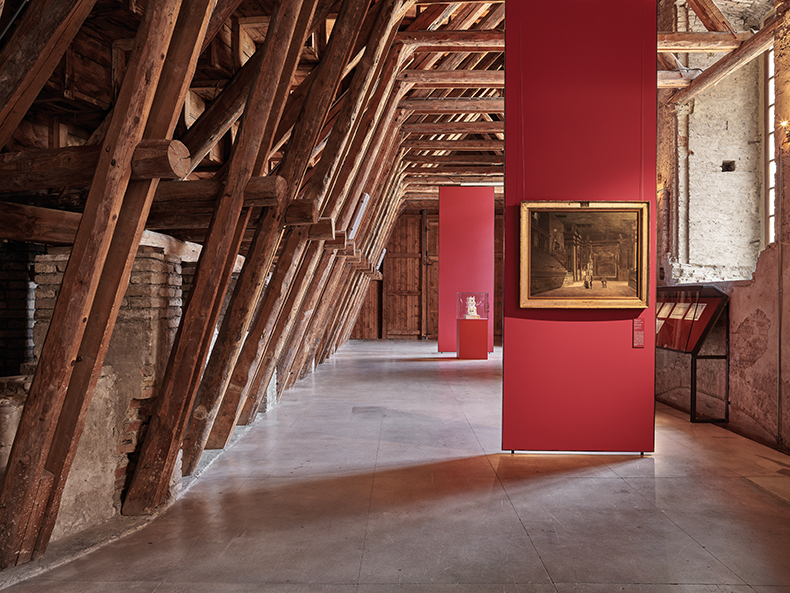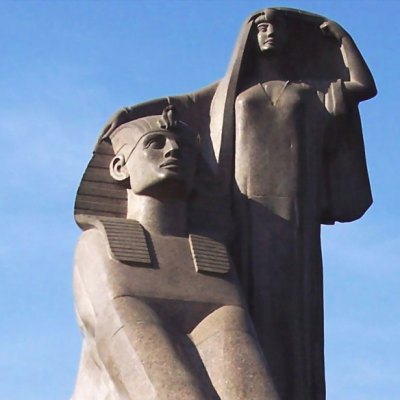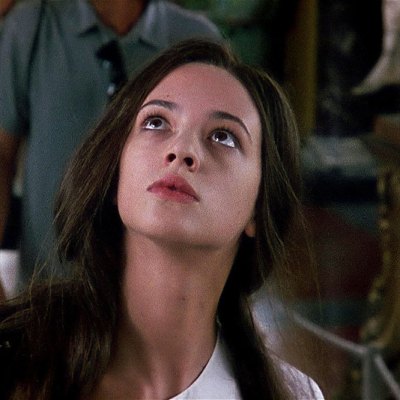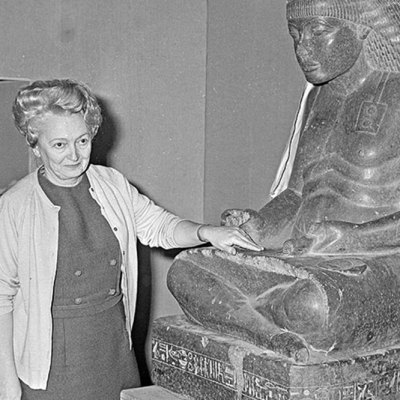From the February 2024 issue of Apollo. Preview and subscribe here.
Gossamer wings, grey against blue heavens, keep aloft the bodies of tumbling, twisting cherubs and the ancient treasures that they hold: a Greek vase, Egyptian statuettes, a tripod table lifted from some long-lost villa. The cherubs are in pairs: two in each octagonal picture field and two octagonal fields in each corner of this vaulted ceiling, its colours brighter than the marble statues placed at intervals around the room below. Perhaps if they had more hands and arms between them, the statues – sober Romans, all – might gesture at each other in animated conversation, as lively as the cherubs overhead. Instead, their eyes gaze blankly towards the windows that line one side of the room, or else their faces turn away, lost in thought and time.
Twelve marble statues of members of the Julio-Claudian dynasty were excavated at Veleia in 1761 and are now in the Museo Archeologico Nazionale in Parma. Photo: Giovanni Hänninen

On a drizzly December day, I found this painted sky a welcome respite not only from the weather, but from the vast corridors, staircases and galleries of the Pilotta in Parma, a city in north-west Emilia-Romagna better known for food and music (Verdi was born nearby) than for archaeology and art. The painted sky, the statues and I were in the Museo Archeologico Nazionale in Parma, one of three museums in this monumental complex. It also hosts a historic library and one of the only surviving Renaissance theatres in Europe. The Pilotta reopened in late November last year, after a six-year redevelopment that has refurbished 30,000 square metres of gallery space and improved accessibility with the addition of lifts, signage and a digital floorplan to help visitors grasp the scale of the place.
As part of the changes, the Museo Archeologico has undergone its first reinstallation since 1965, including the conservation of 550 objects and the creation of a chronological percorso that takes visitors from the prehistory of the region to late antiquity. According to the Roman historian Livy, the colonia of Parma was established in 183 BC, on the Via Emilia that ran south-east to the coast at Rimini. The riverine landscape here, south of the Po, had been settled as early as the Neolithic era, and a simple ceramic figure of a seated woman from c. 4000 BC, found in a woman’s grave at Vicofertile in 2006, is a highlight of the prehistory displays. The museum has a small ancient Egyptian collection, too, mostly acquired during a wave of early 19th-century ‘Egyptomania’.
This is the oldest archaeological museum in Italy, founded in 1760 by Philip I, a Spanish Bourbon prince who inherited the Duchy of Parma through his mother, a member of the Farnese family. The first home of the duke’s Museo di Antichità was a disused fabbricato at the Pilotta, one of several small manufactories housed within this sprawling structure. Begun in the late 16th century, the Pilotta takes its name from the pelota basca ballgame played by Spanish soldiers in its generous courtyards. Facing the river in one direction and the city centre in the other, with its Romanesque cathedral and harmonious baptistery, the Pilotta was a multipurpose complex that connected the reigning families to their capital. It housed the ducal library (today, the Biblioteca Palatina), archives, offices and theatres, including the magnificent wooden Teatro Farnese built in 1618 for court spectacles. To this, Philip added an Academy of Fine Arts and an associated pinacoteca, which is now the Galleria Nazionale.
The Biblioteca Palatina was established in 1761 by Philip, Duke of Parma (r. 1748–65). Photo: Giovanni Hänninen

It was in the paintings gallery that the sober Roman statues – with whom I sheltered from the wintry rain – were originally installed, to instruct and inspire students and public visitors alike. Numbering a dozen, just over life-size and carved from Luni marble (near Carrara), they were found with some of their identifying inscriptions in 1761 at Veleia, some 60km west of Parma. Philip sponsored excavations there and at other sites throughout his reign. He had acceded to the dukedom in 1748; his older brother Charles had become king of Naples and of Sicily some years before and had started digging up the ruins of Pompeii. The subjects of the Veleia statues could sympathise with family rivalries. They are portraits of the Julio-Claudian dynasty, including Augustus and Livia, both Agrippinas, a post-damnatio Caligula (repaired with a head of Claudius) and Nero as a boy, already regal in his child-sized toga.
Philip I’s interest in archaeology was welcome in Parma, which had a circle of antiquaries to rival any in northern Italy. The duke also hired the well-connected antiquary and Theatine father Paolo Maria Paciaudi, who had spent many years in Naples and Rome. As director of the Biblioteca, Paciaudi introduced an index-card cataloguing system and recommended a young typographer named Giovanni Battista Bodoni to head the duke’s press. It was Paciaudi who organised the new antiquities museum, including several Latin inscriptions and bronze figurines from Veleia.
The Museo di Antichità – today’s Museo Archeologico – owes its current place in the Pilotta not to the dukes of Parma, however, but to a duchess. When the Treaty of Vienna carved up Napoleon’s conquests after Waterloo, Parma found a beneficent new patron in Marie-Louise of Austria, the French emperor’s often overlooked second wife. Convinced by her Hapsburg family not to join Napoleon on Elba, Marie-Louise received the Duchy of Parma as a reward and held the title for the rest of her life.
When the duchess arrived in Parma in 1816, she set about bringing the city, and the Pilotta, up to date. Still in her twenties, Marie-Louise was a well-travelled woman, schooled in music and the arts. She had to leave her son by Napoleon behind in Vienna, but accompanying her to Parma, as both lover and court administrator, was Count von Neipperg, a decorated soldier and diplomat who had lost an eye fighting the French. If Marie-Louise relished her new independence, it was to Parma’s benefit. The duchess gave the city its renowned conservatory, the Teatro Regio, a maternity clinic, schools and hospitals. She funded further excavations at Veleia and approved plans to move the old antiquities museum – by now jam-packed – to the first floor of the Pilotta, where it could occupy the former medals room and several chambers either side.
To oversee the changes, Marie-Louise appointed the Parma-born numismatist Michele Lopez as director of the archaeology museum. Lopez planned new displays for the repurposed Sala delle Medaglie and devised a decorative scheme for its ceiling: a personification of Archaeology surrounded by winged cherubs. In 1844, Marie-Louise approved the design and commissioned Francesco Scaramuzza to paint it. Another Parma native, who had trained at the fine arts academy in the Pilotta, Scaramuzza worked in encaustic, melting powdered pigments into hot wax, which had to be applied quickly, while the mixture was warm. Described by Pliny the Elder and used for portraits on wooden panels in Roman times, the technique helps explain the depth and lustre of the surviving colours. Assisting Scaramuzza was decorative painter Girolamo Gelati, who executed the borders, coffering and architrave details in trompe l’oeil marble and stucco effect. Their pallor makes the brightly painted fields stand out all the more.
A personification of Archaeology surrounded by cherubs in the Museo Archeologico Nazionale, painted by Francesco Scaramuzza (1803–86) and commissioned by Marie-Louise, Duchess of Parma (r. 1814–47). Photo: Giovanni Hänninen

The main panel of the ceiling presents Archaeology as a pale-skinned, dark-haired woman draped in trailing robes. She floats against soft clouds with a child either side of her, one holding an ancient statuette aloft and the other a papyrus scroll. In front, a pair of winged cherubs is distracted by a shallow box from which one pulls a string of Egyptian amulets. Variations on the cherub motif repeat at each corner of the ceiling, where its vault springs. Each cherub pair has an antiquity, or two or three, to heft, tilt and admire: a red-figure Greek vase, a Roman bronze, an Etruscan casket, footed cup and mirror and Egyptian figurines depicting Isis and a mummiform Ptah-Sokar. The inclusion of a Black cherub, who helps lift a weighty Osiris statue with a gilded face, was a nod to the African identity of Egypt, something most European scholars at the time took for granted.
Egyptian artefacts had begun to reach Europe in greater numbers as Egypt’s Ottoman ruler Muhammad Ali sought closer commercial and military ties with the continent. France took the lead in studying ancient Egypt, thanks to Napoleon’s invasion of the country in 1798 and Jean-François Champollion’s decipherment of hieroglyphs in 1822. But Lopez was quick to acquire Egyptian antiquities for Parma, buying up collections from Italian artists and travellers. The Italian peninsula had enjoyed a close relationship with Egypt since ancient times, sustained over the centuries by maritime connections, peaceful and otherwise. Lopez and the duchess were also inspired by an expedition the duke of Tuscany and King Charles X of France sponsored in 1828, in the course of which Champollion and Ippolito Rossellini from Pisa travelled the Nile, recording ancient sites and accruing papyri, burial goods and sculptures for Florence and the Louvre. Marie-Louise considered funding a similar scholarly voyage for the benefit of Parma, but she died in 1847, before plans could progress.
Four monotone panels, placed between the cherubic octagons, complete the archaeology-themed ceiling in the Sala delle Medaglie. Each panel represents one of the originating cultures for the artefacts the museum by then contained: Greece, Rome, Etruria and Egypt, each offering its antiquities to Archaeology in an appropriate and idyllic setting – for Egypt, the temple of Dendera, a pyramid and palms. Above, a cameo shows a male scholar already heroised for that panel’s field: Winckelmann for Greece, Ennio Visconti for Rome, Luigi Lanzi for Etruria and Champollion for Egypt, of course. This arrangement at least makes Egypt a peer among equals, an idea that would change later in the 19th century under the influence of scientific racism and imperial competition for control of Africa and the Middle East. Archaeology in occupied lands such as Egypt was no longer a gracious lady surrounded by playful putti, but a tool of conquest and extraction for Europe’s gain.
Gallery spaces have been created behind the seats of the Teatro Farnese. Photo: Giovanni Hänninen

In 1866 the Veleia statues finally joined the rest of the antiquities in the Museo Archeologico, where they have been studiously ignoring the Scaramuzza cherubs ever since. The creation of an unified Italian state in 1861 had made the duchy of Parma obsolete, although the city revived in the 1880s with the arrival of the railway linking Bologna and Milan. Unfortunately for Parma, its train station was a target of Allied bombs in May 1944, which destroyed part of the Pilotta. Ghostly niches, chimneys, joists and stairs still scar its facade. It took some 20 years to restore the Teatro Farnese – the jewel of the complex – and reopen the 700,000-volume library, the picture gallery and the archaeological museum. To these, in 1963, the city added a museum of typography in honour of Bodoni as well.
The refurbishment has updated interventions from the 1960s and ’70s that were no longer fit for purpose and created new spaces with institutional coherence and visitor comfort in mind (although a planned café and restaurant are still to be realised). Admission to the complex is by a single ticket, with no option to visit only one or two parts on a given day (although as at most Italian state museums, the first Sunday of the month is free.) The director who has overseen the Pilotta’s transformation is Simone Verde, soon to move to Florence as the new director of the Uffizi galleries. The redevelopment has carved out display spaces beneath the steep seats of the Teatro Farnese (Fig. 4), which tell its story alongside a digital projection on to the proscenium, animating its different appearances and uses over time. It is sometimes possible to experience the theatre in use, for instance during the Farnese Festival of ancient music, launched just last summer. The Museo Bodoniano has been moved from an upper storey to a suite of rooms on the ground floor, next to the entrance of the Biblioteca Palatina. Both are now reached through a new space named in honour of the librarian and antiquary Paciaudi and created from what had been a damp, cobbled passageway closed off at night by iron gates.
Although not as obvious a change as the overhaul of the Museo Archeologico, the long corridors that comprise the Galleria Nazionale have also been rethought and rehung, equipped with false walls to protect the paintings from bare brick and stone. Some spaces in the Pilotta are too large to heat in Parma’s misty winters and several gallery attendants wore hats and coats when I visited, as did I. Although Philip’s brother Charles took the old ducal collection with him to Naples, there is plenty still to see: a Holbein portrait of Erasmus, works by Tintoretto, Parmigianino, Correggio, El Greco and the Carracci and assorted portraits of Farnese and Bourbon dukes and their respective wives. Marie-Louise has pride of place in the grand gallery of the former Accademia, in a sculpture by Canova, made at Napoleon’s insistence shortly after their marriage. Enthroned as Concordia, the empress would not have looked too much out of place at ancient Veleia.
The exterior of the Palazzo della Pilotta and Maurizio Nannucci (b. 1939)’s installation Time Past, Present and Future (2019). Photo: Giovanni Hänninen

On the upper floor of the Museo Archeologico, above the Sala delle Medaglie, the Egyptian collection has been redisplayed in two grey-walled rooms tucked away in a dead end, still awaiting labels for the new vitrines. Papyri, a coffin and a striking tomb relief are among the objects purchased in Marie-Louise’s day, while a Ptolemaic-era coffin and its wrapped, embalmed remains, from the site of Zagazig, were donated in 1885 during the directorship of archaeologist and politician Giovanni Mariotti, a former student of Lopez. Britain had invaded and occupied Egypt three years earlier to protect its own financial interests. Under the austerity regime Britain imposed, the French-run antiquities service allowed hundreds of thousands of artefacts to leave Egypt, to encourage foreign sponsorship for excavations. This was not Egyptomania, but an alliance of accounting and opportunism.
In the Egyptian rooms, I had hoped to recognise some of the artefacts from Scaramuzza’s ceiling, as if the cherubs had darted down from heaven to lend the curators a hand. But collections, and small children, are rarely so compliant. Ignoring my tired feet (wings would have come in handy), I doubled back to the Sala delle Medaglie for another look. Under that blue encaustic sky, the Roman statues were still staring past each other at the rain. I gazed up again at the paired cherubs, Black and white, holding a statue of Osiris to the light. Their artful innocence comes with a twist, when we know the wider context and what happens next. Complex, monumental and familiar with the scars of war, the new Pilotta is an ideal place to contemplate the longer histories that link art, people and power across time.
From the February 2024 issue of Apollo. Preview and subscribe here.


